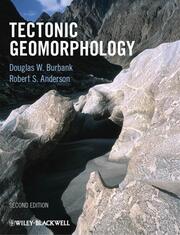Detailansicht
Tectonic Geomorphology
ISBN/EAN: 9781444338874
Umbreit-Nr.: 1900540
Sprache:
Englisch
Umfang: 460 S.
Format in cm: 2.5 x 24.5 x 19
Einband:
kartoniertes Buch
Erschienen am 11.11.2011
Auflage: 2/2011
- Zusatztext
- Tectonic geomorphology is the study of the interplay between tectonic and surface processes that shape the landscape in regions of active deformation and at time scales ranging from days to millions of years. Over the past decade, recent advances in the quantification of both rates and the physical basis of tectonic and surface processes have underpinned an explosion of new research in the field of tectonic geomorphology. Modern tectonic geomorphology is an exceptionally integrative field that utilizes techniques and data derived from studies of geomorphology, seismology, geochronology, structure, geodesy, stratigraphy, meteorology and Quaternary science. While integrating new insights and highlighting controversies from the ten years of research since the 1st edition, this 2nd edition of Tectonic Geomorphology reviews the fundamentals of the subject, including the nature of faulting and folding, the creation and use of geomorphic markers for tracing deformation, chronological techniques that are used to date events and quantify rates, geodetic techniques for defining recent deformation, and paleoseismologic approaches to calibrate past deformation. Overall, this book focuses on the current understanding of the dynamic interplay between surface processes and active tectonics. As it ranges from the timescales of individual earthquakes to the growth and decay of mountain belts, this book provides a timely synthesis of modern research for upper-level undergraduate and graduate earth science students and for practicing geologists. Visit www.wiley.com/go/burbank/geomorphology to access the artwork from the book.
- Kurztext
- Tectonic geomorphology is the study of the interplay between tectonic and surface processes that shape the landscape in regions of active deformation and at time scales ranging from days to millions of years. Over the past decade, recent advances in the quantification of both rates and the physical basis of tectonic and surface processes have underpinned an explosion of new research in the field of tectonic geomorphology. Modern tectonic geomorphology is an exceptionally integrative field that utilizes techniques and data derived from studies of geomorphology, seismology, geochronology, structure, geodesy, stratigraphy, meteorology and Quaternary science. While integrating new insights and highlighting controversies from the ten years of research since the 1st edition, this 2nd edition of Tectonic Geomorphology reviews the fundamentals of the subject, including the nature of faulting and folding, the creation and use of geomorphic markers for tracing deformation, chronological techniques that are used to date events and quantify rates, geodetic techniques for defining recent deformation, and paleoseismologic approaches to calibrate past deformation. Overall, this book focuses on the current understanding of the dynamic interplay between surface processes and active tectonics. As it ranges from the timescales of individual earthquakes to the growth and decay of mountain belts, this book provides a timely synthesis of modern research for upper-level undergraduate and graduate earth science students and for practicing geologists.
- Autorenportrait
- InhaltsangabePreface to First Edition viii Preface to Second Edition xii 1 Introduction to tectonic geomorphology 1 2 Geomorphic markers 17 3 Establishing timing in the landscape: dating methods 45 4 Stress, faults, and folds 71 5 Shortterm deformation: geodesy 117 6 Paleoseismology: ruptures and slip rates 147 7 Rates of erosion and uplift 195 8 Holocene deformation and landscape responses 243 9 Deformation and geomorphology at intermediate time scales 274 10 Tectonic geomorphology at late Cenozoic time scales 316 11 Numerical modeling of landscape evolution 370 References 412 Index 444 Colour plate section appears between pages 226 and 227
